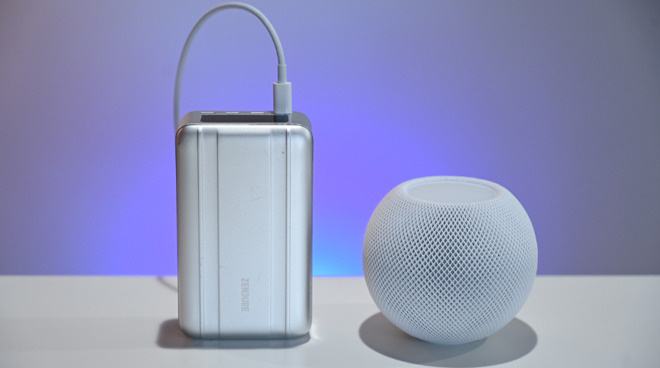HomePod mini works with 18W power supplies after 14.3 software update
Thanks to the HomePod version 14.3 update, Apple's new HomePod mini now supports 18W power adapters or battery packs

HomePod mini will now work with 18W power sources and adapters
The HomePod mini ships with a 20W power adapter and originally required at least 20W to function. An update reduces this limit to 18W, which enables a wider range of adapters and battery packs to work.
The 8-Bit reports that Reddit users discovered the change when testing different power adapters. Apple did not disclose the change in the update notes, but if you use a certified 18W USB-C PD power supply or one offering a greater wattage, you'll be able to run your HomePod mini without issue.
As AppleInsider previously covered, you can even connect your HomePod mini to a battery pack to create a portable AirPlay 2 speaker. As long as you have a proper WiFi signal for the HomePod mini to connect through, all functions should work as normal, even under battery power.
The update doesn't affect the power of the original HomePod, as that model requires a direct connection to a power outlet via a plug, rather than a power adapter.

HomePod mini will now work with 18W power sources and adapters
The HomePod mini ships with a 20W power adapter and originally required at least 20W to function. An update reduces this limit to 18W, which enables a wider range of adapters and battery packs to work.
The 8-Bit reports that Reddit users discovered the change when testing different power adapters. Apple did not disclose the change in the update notes, but if you use a certified 18W USB-C PD power supply or one offering a greater wattage, you'll be able to run your HomePod mini without issue.
As AppleInsider previously covered, you can even connect your HomePod mini to a battery pack to create a portable AirPlay 2 speaker. As long as you have a proper WiFi signal for the HomePod mini to connect through, all functions should work as normal, even under battery power.
The update doesn't affect the power of the original HomePod, as that model requires a direct connection to a power outlet via a plug, rather than a power adapter.

Comments
As for the power requirement of the HomePod mini... somebody would need to actually measure the current draw in a worst case scenario (likely maximum volume - probably with a lot of bass). That said, what it requires is probably not 18 watts continuous. It might not sound like much, but 18 watts without good heat dissipation adds up quickly and electronics do not like heat. Those little 5 watt night light bulbs get wicked hot, and they are in a free air environment.
USB Power delivery specifies profiles different voltages (5, 9, 15 or 20V) and different currents ranging from 0.5 - 20A. The voltage is actually negotiated between the device and the supply. If the HomePod wasn't designed to work with an older version, it may not have been able to negotiate an appropriate voltage/current combination.
Two of your statements are a bit contradictory though:
- "The original USB Spec was for 5V; you're not going to run 20 amps through a USB cable to charge your laptop at 100 watts."
- "USB Power delivery specifies profiles different voltages (5, 9, 15 or 20V) and different currents ranging from 0.5 - 20A."
The first statement says you are not going to run 20 Amps through a USB cable while the second statement says you can.
Please clarify.
Regarding the current, I misspoke (mistyped) - the currents range from 0.5-5A, not 20A.
Here's a link with more detail if you're so inclined: https://electronics.stackexchange.com/questions/265832/how-does-usb-power-delivery-work-with-voltages-above-5v-without-damaging-5v-peri
Not the current, the voltage should be at least 9V for HomePod mini.